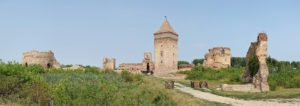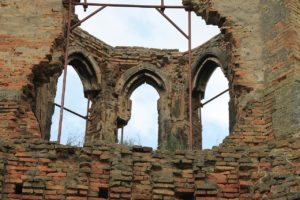Bács Castle

The castle of Bács was founded by our first Hungarian king, King St. István, and it was the center of Bácska County. It is located in Serbia. In Serbian, the town is known as Bač (Бач); in Slovak as Báč; in Croatian (Šokac) as Bač; in Hungarian as Bács; in German as Batsch. Please, note that I use the Eastern name order for Hungarians where family names come first.

King Ladislaus I (Szent lászló) made the town the seat of a new archbishopric in 1085. The current name of the town was first recorded in 1092 when its fort was built. In 1111 the parish was mentioned as Bache. In 1154, the Arab geographer Idrisi mentions it under the name Bakasin and claim that “it is a famous city that was mentioned among old big cities”. The first castle was not made of stone so the Mongols could burn it down in 1241.
The castle was built in French fashion, with 8 bastions. There were three moats around it and two churches inside. The defenders slept in a common hall built near the main gate’s wall. It was King Károly Róbert between 1338-42 who had the fort reinforced. Several Diets were held in the city and King Matthias Corvinus and King Ulászló II used to like staying in the castle.

It was Bishop Váradi Péter of King Matthias who first realized the Turkish peril and had the water of the Danube River flow in the moats. Frangepán Gergely, the Archbishop of Kalocsa took shelter in the castle in 1514 in fear of the rebelling peasants of Dózsa György. Let us remember here Cardinal Bakócz Tamás who had assembled the scum to lead a crusade against the Turks.

Bakócz wanted to be the next Pope with this move but the peasants never got paid so they revolted and destroyed half of the country. It would be interesting to research this part of our history since it greatly contributed to the disaster of Mohács in 1526. The seasoned warriors of the garrison of Nándorfehérvár (Belgrade) finally scattered the besieging peasants and relieved Bács so the Archbishop could escape.
The Turks took Bács in 1526 for a short time but they occupied it permanently in 1529. Only 106 Serbian mercenaries were guarding it in 1543. Most of the garrisons on the Ottoman Occupied Lands of Hungary consisted of mostly Serbian or some kind of Balkanian troops, according to the Ottoman pay lists their rate was 92%.

The castle was taken by the Christians in 1604 for two short years. Then the “valiant” defenders had the walls explode in several places and they fled from the Turks. There were only 6 artillerymen and 10 infantrymen in it in 1628, not to mention the Serbian irregulars. During Ottoman rule (16th-17th century), Bács was the seat of a Kaza (Turkish administration district of a bigger area) of Bács in Sanjak of Szeged.

The fort was surrendered to the Habsburgs without a fight in 1686 who garrisoned it with Serbian guards, for a change. The castle was burnt in 1704 by the rebels of Prince Rákóczi Ferenc and it was finally exploded the next year by its German garrison who emptied the fort.

Dear Readers, I can only make this content available through small donations or by selling my books or T-shirts:
Please, feel free to support me with a coffee here:
You can check out my books on Amazon or Draft2Digital, they are available in hardcover, paperback, or ebook:
https://www.amazon.com/dp/198020490X or at https://books2read.com/b/boYd81

My work can also be followed and supported on Patreon: Become a Patron!http://Become a Patron!

[wpedon id=”9140″]

https://hungarianottomanwars.myspreadshop.com/all






























